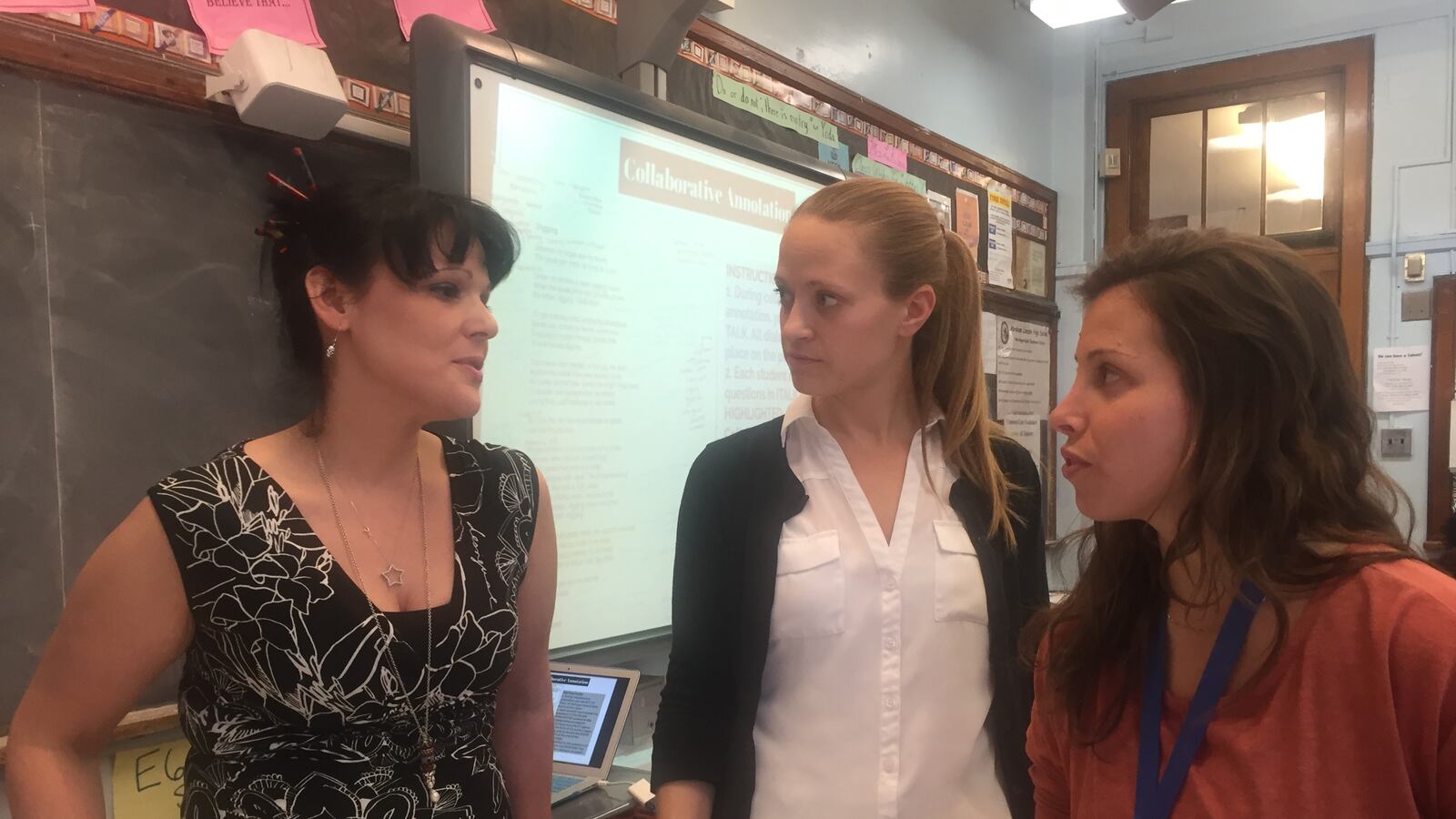As an earth science teacher, Sofia Di Bari never thought her biggest challenge would be teaching English. But her students at Brooklyn’s Abraham Lincoln High School are often missing key language skills that would help them discuss scientific evidence or find the slope of a line.
“I’m not an English teacher,” Di Bari said. “How do I even begin to teach a subject I don’t teach?”
It was a question she brought recently to a group of fellow first-year teachers, including Vincent Garcia. He had his own dilemma to share: a student who acts up by dancing in the middle of class. “I think he knows he’s pushing my buttons,” Garcia told the group.
The group of new teachers at Lincoln occasionally meets all day to troubleshoot problems, hear tips from more experienced teachers, and watch other colleagues in action. It’s a small part of a big investment in training at Lincoln, one of New York City’s remaining large high schools, where select teachers are pulled out of their classrooms for targeted learning.
The program is in line with Chancellor Carmen Fariña’s belief that exchanging ideas among educators holds the key to improving schools. It also requires time and resources, and having teachers spend more time out of the classroom could also be something of a gamble for a school struggling to raise a 67 percent four-year graduation rate.
But Principal Ari Hoogenboom said the school’s flagging Regents exam scores make it even more urgent to help teachers improve their craft so that they can help students become better problem solvers. Without those skills, students have struggled when faced with slightly unfamiliar questions, he said.
“It’s as if we had trained our students to play cricket and then made them play baseball,” Hoogenboom said.
The school’s emphasis on teacher training doubles down on a trade-off made in the city’s teacher contract, which requires teachers to spend 80 minutes on professional development each week but took away time for student tutoring. The city has encouraged teachers to lead that new training time.
At those 80-minute sessions, which Lincoln holds every Friday, teachers choose from workshops their colleagues have created once a month, with topics ranging from test-taking tips to theater games teacher can use with students.
But teachers also run additional programs for others who need more targeted help, like the first-year teachers.
Sarah Fanning, a ninth-grade science teacher who leads the group, said she noticed the chance to be away from the classroom for a full day three times a semester has been a huge help for the first-year teachers.
“The first moment that we had the group here together, it was like they breathed a sigh of relief,” Fanning said of her fellow teachers.
Besides talking about classroom problems, the program provides a chance for newer teachers to ask questions of those with more experience. On a recent Tuesday, during one of the full-day sessions, teachers walked around an English as a second language class with Spanish-English dictionaries, Arabic-English dictionaries and Uzbeki-English dictionaries sprawled across classroom tables. They stopped to watch and ask their colleagues about how they planned the lesson around so many languages.
Teachers say Abraham Lincoln’s size makes for a diverse student body where lively classroom conversations are common. It also presents a pedagogical challenge for teachers trying to navigate students of varying backgrounds and abilities.
“We’re really good at giving them scaffolds,” Hoogenboom said. “We’re not as good at gradually removing them.”
As it tries to solve that puzzle, the school is trying to use its size to its advantage. At a smaller school, there wouldn’t be as many teachers to lend support and expertise — or enough first-year teachers to form a group, said Wayne Gagnon, a 12th grade English teacher and one of the architects of the school’s professional development programs.
Lincoln is just one of example of a school investing time in teacher-driven training, said Jennifer Murtha, the chief operating officer at Teaching Matters, an organization dedicated to increasing teacher effectiveness. Even three years ago, Murtha said such a program would have been pretty rare.
“We’ve been seeing a huge shift,” Murtha said. “Teachers are being empowered more and more to be leaders.”
At Lincoln, school officials say they’re hoping the training will lead to better test scores and higher graduation rates.
“We haven’t seen the payoff yet,” Hoogenboom said. “I’m hoping we’re over the dip.”

